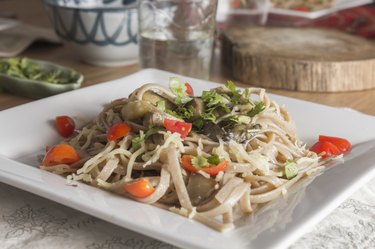
A nutritious 2,400-calorie meal plan is built on a foundation of whole, unprocessed foods. While 2,400 calories is a high enough amount to allow for some discretionary calories to come from foods such as sugars, alcohol and extra portions, about 90 percent of calories should come from nutritious sources. Divide your 2,400 calories over three meals and two snacks to make it easier to fit in all the foods you need on a healthy plan.
Significance
Video of the Day
Eating an appropriate number of calories for your activity level helps you maintain a healthy weight. Consuming fewer calories than you burn leads to weight loss, and eating a greater number leads to weight gain. According to the U.S. Department of Agriculture and Department of Health and Human Services, a 2,400-calorie meal plan is appropriate for active women ages 19 to 30 years and for almost all adult men. For some men, 2,400 calories will induce weight loss; for those who are sedentary, 2,400 calories may exceed their calorie-burn rate and cause them to put on pounds.
Video of the Day
Balanced Nutrition
A 2,400-calorie meal plan features foods from all five major food groups as defined by the USDA Food Guide Pyramid. Aim for eight 1-oz. servings of grains, 3 cups of vegetables, 2 cups of fruit, 3 cups of milk and 6.5 oz. of meat or beans daily. Make at least four of the grain servings from whole grain foods. At least 20 percent and no more than 35 percent of your daily calories should come from fats, preferably unsaturated types.
Types of Food
Whole grains include brown rice, whole-wheat pasta, whole-grain bread or pancakes, quinoa, and bran or oat cereals. Indulge in a wide range of colorful, fibrous vegetables such as eggplant, cauliflower, red peppers, winter squash and spinach. Whole fruits contain more fiber and make you feel fuller than fruit juices. Opt for low-fat or non-fat dairy products such as skim milk or nonfat plain yogurt. Fish and poultry are animal products low in saturated fats, while vegetarian protein options include beans, lentils and soy products.
Meal Ideas
Each meal could contain about 600 calories, and each snack about 300 calories. At breakfast, whip up a smoothie made with a whole banana, a cup of skim milk, a few ice cubes and a tbsp. of peanut butter. Have alongside two scrambled eggs and a whole-grain English muffin. This breakfast contains 570 calories, 70 g of carbohydrates, 18 g of fat and 31 g of protein. At lunch, make a pasta salad with a cup of whole wheat penne, ½ cup of diced chicken breast, ¼ cup of feta cheese, diced red bell pepper and roma tomatoes. Toss with a salad dressing made with 1 tbsp. of olive oil, Italian seasoning and red wine vinegar. With an orange for dessert, this lunch contains 639 calories, 28 g of fat, 75 g of carbohydrates and 36 g of protein. At dinnertime, grill 3 oz. of salmon and eat with a cup of brown rice and a small baked sweet potato. Have a large spinach salad on the side and two fig cookies for dessert for a total of 636 calories, 12 g of fat, 99 g of carbohydrates and 28 g of protein.
Snacks
For a midmorning snack, have ½ cup of part-skim ricotta cheese with 2 tbsp. of slivered almonds and ½ cup of fresh blueberries for 327 calories, 21 g of fat, 21 g of carbohydrates and 17 g of protein. An afternoon snack may consist of 2 tbsp. of hummus with 10 whole-grain crackers for 230 calories, 9 g of fat, 35 g of carbs and 5 g of protein. Quick and easy snacks such as low-fat yogurt with fruit or trail mix are also options.